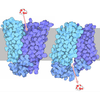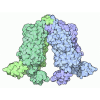+ Open data
Open data
- Basic information
Basic information
| Entry |  | ||||||||||||||||||||||||||||||
|---|---|---|---|---|---|---|---|---|---|---|---|---|---|---|---|---|---|---|---|---|---|---|---|---|---|---|---|---|---|---|---|
| Title | NorA single mutant - D307N at pH 7.5 | ||||||||||||||||||||||||||||||
 Map data Map data | |||||||||||||||||||||||||||||||
 Sample Sample |
| ||||||||||||||||||||||||||||||
 Keywords Keywords | D307N NorA / efflux pump / MRSA / TRANSPORT PROTEIN / TRANSPORT PROTEIN-IMMUNE SYSTEM complex | ||||||||||||||||||||||||||||||
| Function / homology |  Function and homology information Function and homology information | ||||||||||||||||||||||||||||||
| Biological species |   Homo sapiens (human) Homo sapiens (human) | ||||||||||||||||||||||||||||||
| Method | single particle reconstruction / cryo EM / Resolution: 3.54 Å | ||||||||||||||||||||||||||||||
 Authors Authors | Li JP / Li Y / Koide A / Kuang HH / Torres VJ / Koide S / Wang DN / Traaseth NJ | ||||||||||||||||||||||||||||||
| Funding support |  United States, 9 items United States, 9 items
| ||||||||||||||||||||||||||||||
 Citation Citation |  Journal: Nat Commun / Year: 2024 Journal: Nat Commun / Year: 2024Title: Proton-coupled transport mechanism of the efflux pump NorA. Authors: Jianping Li / Yan Li / Akiko Koide / Huihui Kuang / Victor J Torres / Shohei Koide / Da-Neng Wang / Nathaniel J Traaseth /  Abstract: Efflux pump antiporters confer drug resistance to bacteria by coupling proton import with the expulsion of antibiotics from the cytoplasm. Despite efforts there remains a lack of understanding as to ...Efflux pump antiporters confer drug resistance to bacteria by coupling proton import with the expulsion of antibiotics from the cytoplasm. Despite efforts there remains a lack of understanding as to how acid/base chemistry drives drug efflux. Here, we uncover the proton-coupling mechanism of the Staphylococcus aureus efflux pump NorA by elucidating structures in various protonation states of two essential acidic residues using cryo-EM. Protonation of Glu222 and Asp307 within the C-terminal domain stabilized the inward-occluded conformation by forming hydrogen bonds between the acidic residues and a single helix within the N-terminal domain responsible for occluding the substrate binding pocket. Remarkably, deprotonation of both Glu222 and Asp307 is needed to release interdomain tethering interactions, leading to opening of the pocket for antibiotic entry. Hence, the two acidic residues serve as a "belt and suspenders" protection mechanism to prevent simultaneous binding of protons and drug that enforce NorA coupling stoichiometry and confer antibiotic resistance. | ||||||||||||||||||||||||||||||
| History |
|
- Structure visualization
Structure visualization
| Supplemental images |
|---|
- Downloads & links
Downloads & links
-EMDB archive
| Map data |  emd_41608.map.gz emd_41608.map.gz | 59.8 MB |  EMDB map data format EMDB map data format | |
|---|---|---|---|---|
| Header (meta data) |  emd-41608-v30.xml emd-41608-v30.xml emd-41608.xml emd-41608.xml | 20.9 KB 20.9 KB | Display Display |  EMDB header EMDB header |
| FSC (resolution estimation) |  emd_41608_fsc.xml emd_41608_fsc.xml | 8.5 KB | Display |  FSC data file FSC data file |
| Images |  emd_41608.png emd_41608.png | 53 KB | ||
| Masks |  emd_41608_msk_1.map emd_41608_msk_1.map | 64 MB |  Mask map Mask map | |
| Filedesc metadata |  emd-41608.cif.gz emd-41608.cif.gz | 6.3 KB | ||
| Others |  emd_41608_half_map_1.map.gz emd_41608_half_map_1.map.gz emd_41608_half_map_2.map.gz emd_41608_half_map_2.map.gz | 59.3 MB 59.2 MB | ||
| Archive directory |  http://ftp.pdbj.org/pub/emdb/structures/EMD-41608 http://ftp.pdbj.org/pub/emdb/structures/EMD-41608 ftp://ftp.pdbj.org/pub/emdb/structures/EMD-41608 ftp://ftp.pdbj.org/pub/emdb/structures/EMD-41608 | HTTPS FTP |
-Validation report
| Summary document |  emd_41608_validation.pdf.gz emd_41608_validation.pdf.gz | 857.1 KB | Display |  EMDB validaton report EMDB validaton report |
|---|---|---|---|---|
| Full document |  emd_41608_full_validation.pdf.gz emd_41608_full_validation.pdf.gz | 856.7 KB | Display | |
| Data in XML |  emd_41608_validation.xml.gz emd_41608_validation.xml.gz | 16.3 KB | Display | |
| Data in CIF |  emd_41608_validation.cif.gz emd_41608_validation.cif.gz | 21.1 KB | Display | |
| Arichive directory |  https://ftp.pdbj.org/pub/emdb/validation_reports/EMD-41608 https://ftp.pdbj.org/pub/emdb/validation_reports/EMD-41608 ftp://ftp.pdbj.org/pub/emdb/validation_reports/EMD-41608 ftp://ftp.pdbj.org/pub/emdb/validation_reports/EMD-41608 | HTTPS FTP |
-Related structure data
| Related structure data |  8tthMC  8tteC  8ttfC  8ttgC C: citing same article ( M: atomic model generated by this map |
|---|---|
| Similar structure data | Similarity search - Function & homology  F&H Search F&H Search |
- Links
Links
| EMDB pages |  EMDB (EBI/PDBe) / EMDB (EBI/PDBe) /  EMDataResource EMDataResource |
|---|---|
| Related items in Molecule of the Month |
- Map
Map
| File |  Download / File: emd_41608.map.gz / Format: CCP4 / Size: 64 MB / Type: IMAGE STORED AS FLOATING POINT NUMBER (4 BYTES) Download / File: emd_41608.map.gz / Format: CCP4 / Size: 64 MB / Type: IMAGE STORED AS FLOATING POINT NUMBER (4 BYTES) | ||||||||||||||||||||||||||||||||||||
|---|---|---|---|---|---|---|---|---|---|---|---|---|---|---|---|---|---|---|---|---|---|---|---|---|---|---|---|---|---|---|---|---|---|---|---|---|---|
| Projections & slices | Image control
Images are generated by Spider. | ||||||||||||||||||||||||||||||||||||
| Voxel size | X=Y=Z: 0.825 Å | ||||||||||||||||||||||||||||||||||||
| Density |
| ||||||||||||||||||||||||||||||||||||
| Symmetry | Space group: 1 | ||||||||||||||||||||||||||||||||||||
| Details | EMDB XML:
|
-Supplemental data
-Mask #1
| File |  emd_41608_msk_1.map emd_41608_msk_1.map | ||||||||||||
|---|---|---|---|---|---|---|---|---|---|---|---|---|---|
| Projections & Slices |
| ||||||||||||
| Density Histograms |
-Half map: #1
| File | emd_41608_half_map_1.map | ||||||||||||
|---|---|---|---|---|---|---|---|---|---|---|---|---|---|
| Projections & Slices |
| ||||||||||||
| Density Histograms |
-Half map: #2
| File | emd_41608_half_map_2.map | ||||||||||||
|---|---|---|---|---|---|---|---|---|---|---|---|---|---|
| Projections & Slices |
| ||||||||||||
| Density Histograms |
- Sample components
Sample components
-Entire : D307N-NorA:FabDA1
| Entire | Name: D307N-NorA:FabDA1 |
|---|---|
| Components |
|
-Supramolecule #1: D307N-NorA:FabDA1
| Supramolecule | Name: D307N-NorA:FabDA1 / type: complex / ID: 1 / Parent: 0 / Macromolecule list: all |
|---|---|
| Source (natural) | Organism:  |
| Molecular weight | Theoretical: 100.656 KDa |
-Macromolecule #1: Quinolone resistance protein NorA
| Macromolecule | Name: Quinolone resistance protein NorA / type: protein_or_peptide / ID: 1 / Number of copies: 1 / Enantiomer: LEVO |
|---|---|
| Source (natural) | Organism:  |
| Molecular weight | Theoretical: 46.654863 KDa |
| Recombinant expression | Organism:  |
| Sequence | String: MNKQIFVLYF NIFLIFLGIG LVIPVLPVYL KDLGLTGSDL GLLVAAFALS QMIISPFGGT LADKLGKKLI ICIGLILFSV SEFMFAVGH NFSVLMLSRV IGGMSAGMVM PGVTGLIADI SPSHQKAKNF GYMSAIINSG FILGPGIGGF MAEVSHRMPF Y FAGALGIL ...String: MNKQIFVLYF NIFLIFLGIG LVIPVLPVYL KDLGLTGSDL GLLVAAFALS QMIISPFGGT LADKLGKKLI ICIGLILFSV SEFMFAVGH NFSVLMLSRV IGGMSAGMVM PGVTGLIADI SPSHQKAKNF GYMSAIINSG FILGPGIGGF MAEVSHRMPF Y FAGALGIL AFIMSIVLIH DPKKSTTSGF QKLEPQLLTK INWKVFITPV ILTLVLSFGL SAFETLYSLY TADKVNYSPK DI SIAITGG GIFGALFQIY FFDKFMKYFS ELTFIAWSLL YSVVVLILLV FANDYWSIML ISFVVFIGFN MIRPAITNYF SNI AGERQG FAGGLNSTFT SMGNFIGPLI AGALFDVHIE APIYMAIGVS LAGVVIVLIE KQHRAKLKEQ NMENLYFQGK LGPE QKLIS EEDLNSAVDH HHHHHHHHH UniProtKB: Quinolone resistance protein NorA |
-Macromolecule #2: Heavy Chain of FabDA1 Variable Domain
| Macromolecule | Name: Heavy Chain of FabDA1 Variable Domain / type: protein_or_peptide / ID: 2 / Number of copies: 1 / Enantiomer: LEVO |
|---|---|
| Source (natural) | Organism:  Homo sapiens (human) Homo sapiens (human) |
| Molecular weight | Theoretical: 14.070568 KDa |
| Recombinant expression | Organism:  |
| Sequence | String: EVQLVESGGG LVQPGGSLRL SCAASGFTFS SSSIHWVRQA PGKGLEWVAS ISSSSGSTSY ADSVKGRFTI SADTSKNTAY LQMNSLRAE DTAVYYCARM SVENHWYYFY WYMSPYAMDY WGQGTLVTV |
-Macromolecule #3: Light Chain of FabDA1 Variable Domain
| Macromolecule | Name: Light Chain of FabDA1 Variable Domain / type: protein_or_peptide / ID: 3 / Number of copies: 1 / Enantiomer: LEVO |
|---|---|
| Source (natural) | Organism:  Homo sapiens (human) Homo sapiens (human) |
| Molecular weight | Theoretical: 11.209451 KDa |
| Recombinant expression | Organism:  |
| Sequence | String: IQMTQSPSSL SASVGDRVTI TCRASQSVSS AVAWYQQKPG KAPKLLIYSA SSLYSGVPSR FSGSRSGTDF TLTISSLQPE DFATYYCQQ SSSSLITFGQ GTKVEI |
-Experimental details
-Structure determination
| Method | cryo EM |
|---|---|
 Processing Processing | single particle reconstruction |
| Aggregation state | particle |
- Sample preparation
Sample preparation
| Buffer | pH: 7.5 Component:
| |||||||||
|---|---|---|---|---|---|---|---|---|---|---|
| Vitrification | Cryogen name: ETHANE |
- Electron microscopy
Electron microscopy
| Microscope | FEI TITAN KRIOS |
|---|---|
| Temperature | Min: 77.0 K / Max: 77.0 K |
| Image recording | Film or detector model: GATAN K3 BIOQUANTUM (6k x 4k) / Digitization - Dimensions - Width: 5760 pixel / Digitization - Dimensions - Height: 4092 pixel / Average exposure time: 1.2 sec. / Average electron dose: 52.96 e/Å2 |
| Electron beam | Acceleration voltage: 300 kV / Electron source:  FIELD EMISSION GUN FIELD EMISSION GUN |
| Electron optics | C2 aperture diameter: 100.0 µm / Illumination mode: FLOOD BEAM / Imaging mode: BRIGHT FIELD / Cs: 2.7 mm / Nominal defocus max: 2.0 µm / Nominal defocus min: 1.0 µm / Nominal magnification: 105000 |
| Sample stage | Specimen holder model: FEI TITAN KRIOS AUTOGRID HOLDER / Cooling holder cryogen: NITROGEN |
| Experimental equipment |  Model: Titan Krios / Image courtesy: FEI Company |
 Movie
Movie Controller
Controller










 Z (Sec.)
Z (Sec.) Y (Row.)
Y (Row.) X (Col.)
X (Col.)













































